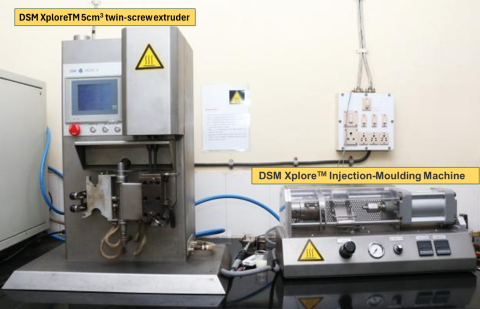
Make
Thermo and DSM
Model
DSM XploreTM 5cc twin-screw extruder, Process 11 twin screw extruder, Haake Mini Jet pro, Single screw extruder
Facility Status
Working
Date of Installation
Facility Management Division
Centre for Sophisticated Research Facilities (CSIF- IoE Funded*)
.
Category
- Fabrication and Processing » Macrofabrication
Booking Details
Slot Booking Link
Booking available for
Internal and External Both
Available Equipment/ Mode of use
"DSM XploreTM 5cm3 twin-screw extruder" : 1) Conical Twin Screw: Co-rotating, 2) Injection molding (DSM XploreTM 3,5 cm3 Laboratory Injection-Moulding) ,3) Recirculation facility ,4) Tensile/rectangular mold
"Haake Mini Jet pro": 1) Injection molding, 2) Molds: Tensile (ISO/ASTM/Type three), Disc, Rectangular
"Process 11 corotating twin screw extruder": 1) Extruder: Parallel and Twin die 2) Feeders: Gravimetric single/twin screw feeder ,3) Set of dies (Sheet; Fiber Spinning; Catheter; Filament) ,4) Melt pump ,5) Take-up spool and winder; 6) Pelletizer
"Single Screw Extruder": 1) Single Screw, 2) Sheet die
Facility Management Team and Location
Faculty In Charge
Prof. Guruswamy Kumaraswamy
Email: guruswamy@iitb.ac.in
Co-convenors
Prof. Guruswamy Kumaraswamy
Prof. Jayesh Bellare
Prof. D N Singh
Prof. D V Khakhar
Prof. Rohit Srivastava
Prof. Parag Bhargava
Facility Manager
Vishakha Bansod
Facility Operator
Vishakha Bansod
Lab Email ID
mcimolding@iitb.ac.in
Facility Location
F-3 shed (https://maps.app.goo.gl/svUfYo7MekSrUJ2m7 , across from MMMF lab)
Lab Phone No
+91 22 2576 6162
Facility Features, Working Principle and Specifications
Features Working Principle
Features :
- Twin screw extruder (5cc DSM and Haake Process 11)
- Recirculation (for DSM)
- Use pellet, powder, or melt samples
- Provides efficient sample preparation for mechanical and rheological testing
- Diameter monitor for the strand
- Sheet take-off setup
Working principle :
The majority of polymeric raw materials are available in granules, powder, or flakes form. The transformation from solid to flowable form is carried out by heating the material. Once the material is in a melted state, mold is used to shape the material, and the resulting shape is then fixed by cooling.
Body Specification
Types of material we can use:
- Most thermoplastic materials, including blends, filled systems, etc.
- Size of material we can use: Typically pellets of 1-2 mm size
- Maximum temperature range of machine: 450 degree Celsius
Instructions for Registration, Sample Preparation, User Instructions and Precautionary Measures
Instructions for Registration
- User can register only through IRCC site.
- The date and time of slot will be informed to user by an email. If user cannot come, a mail should be immediately sent to mcimolding@iitb.ac.in into cancel his/her slot.
Instruction for Sample Preparation
- Material should be dry, and its melting temperature should be within 300 °C
- Required sample volume depends on the instrument type that will be used.
- Carry an extra 20 -30gm of your material.
User Instructions and Precautionary Measures
Instructions for users:
- Online registrations will be accepted only through the IRCC webpage. If anyone wants to cancel their slot, need to send an email immediately with an explanation.
- Slots will be provided depending on availability.
- Users must be present during the entire slot.
- Material should be oven dried before usage.
- User should be aware of the melting temperature and degradation temperature.
- Material should be free from toxin material or any harmful gases.
- Fillers that can stick to the barrel walls will not be accepted
Charges for Analytical Services in Different Categories
Applications
- Polymer melt processing, including blends, addition of additives and fillers.
- Preparation of samples using injection molding (variety of moulds are available).
- Formulation: Analyze the influence of types of additives, fillers, concentrations, polymer types, etc.
- Processing: Measure the impact of processing time and temperature.
- Performance: Predict the performance of the material before actual application.
Sample Details
Chemical allowed
--
Gases allowed
--
Substrate Dimension
--
Target dimension
--
Contamination remarks
--
Precursors/ Targets allowed
--
SOP, Lab Policies and Other Details
Publications
--
